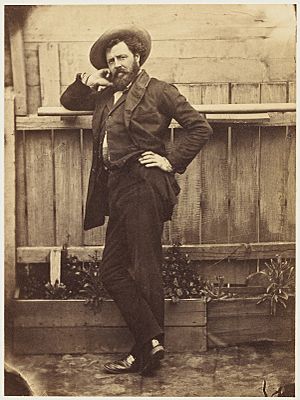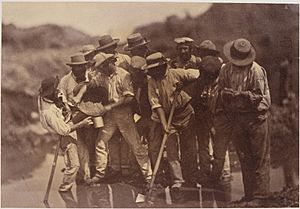Antoine Fauchery facts for kids
Quick facts for kids
Antoine Fauchery
|
|
|---|---|

Fauchery c. 1858
|
|
| Born | 15 November 1823 |
| Died | April 1861 (aged 37–38) |
| Occupation | Adventurer, writer, photographer |
| Parent(s) | Julien Fauchery Sophie Gilberte Soré |
Antoine Julien Nicolas Fauchery (born November 15, 1823 – died 1861) was a French adventurer, writer, and photographer. He lived an exciting life, traveling to many parts of the world.
He took part in a Polish uprising in 1848. Later, he opened a photography studio in Melbourne, Australia, in 1858.
In 1860, he was asked to join French soldiers traveling to Beijing during the Second Opium War. He wrote many reports from the war for a French newspaper. Antoine Fauchery sadly died in Yokohama, Japan, from an illness.
Contents
Antoine Fauchery's Early Life
Antoine Fauchery was born in Paris, France. His father, Julien Fauchery, was a merchant. Antoine was interested in architecture, painting, and engraving from a young age.
Becoming a Writer and Adventurer
In 1844, Antoine Fauchery met the poet Théodore de Banville in a café. This meeting helped him start his journey as a writer. He joined a group of creative friends, including famous writers like Henri Murger and Charles Baudelaire.
Fauchery wrote articles for a journal called Le Corsaire-Satan. He also drew portraits of important people, like writer Alexandre Dumas.
In 1848, Fauchery and his friend, photographer Nadar, went on an adventure. They joined a group of French and Polish people who wanted to help Poland become free from Russia. However, they soon ran out of money and had to return to France.
Fauchery's friend, Henri Murger, even created a character based on Antoine in his novel Scènes de la vie de Bohème. This character was a painter named Marcel.
Between 1848 and 1852, Fauchery wrote many short plays and stories. These were published in different journals.
Adventures in Australia
In July 1852, Fauchery sailed from England to Australia with a companion named Louise. He spent about four years in Australia.
When he arrived in Melbourne, he was inspired to go to the goldfields. He spent two years digging for gold at the Ballarat Goldfields during the Victorian Gold Rush. He didn't find much gold himself, but he saw others strike it rich.
After the goldfields, Fauchery opened a café in Melbourne. It was called Café Estaminet Français and was a place for Europeans to meet and play billiards. Later, he tried running a store at the Jim Crow gold diggings, but it wasn't successful.
Returning to Europe and Writing
Fauchery returned to Europe in 1856. He had written a play with Théodore Barrière called Calino, charge d'atelier, which was successfully performed in Paris.
His letters, written while he was a gold miner in Australia, were published in a French newspaper called Le Moniteur Universel. These letters were later made into a book in 1857. The book, Lettres d'un minuer en Australie, shared stories about daily life in the goldfields.
Back to Australia as a Photographer
The French government gave Fauchery money to take photographs in Australia, India, and China. So, he returned to Port Phillip, Australia, in late 1857.
In January 1858, he opened a photography studio in Melbourne. He brought examples of famous people's portraits with him. In February of that year, he won a gold medal for his portraits at an exhibition.
As a working photographer, he took pictures of the Melbourne Volunteer Artillery Regiment in November 1858. He captured them during their artillery practice.
Sun Pictures of Victoria
Antoine Fauchery created an important photo album called Sun Pictures of Victoria. He worked with another photographer, Richard Daintree, on this project.
The album included photos of Melbourne, the Victorian goldfields, and Aboriginal Australians. These pictures are some of the only images that exist from that time. They show what life was like in the goldfields and how Aboriginal people lived.
A photography expert, Jack Cato, studied a copy of Sun Pictures. He found that Fauchery used a special lens for some photos. This lens made the main subject look very sharp, while the background was a bit blurry. This made the subject seem to stand out.
Final Journeys and Death
In February 1859, Fauchery left Australia for Manila. In 1860, the French government gave him more money. They wanted him to join a military trip to China as a photographer and war reporter.
From July to November 1860, he was in China. He sent regular reports back to France. These letters, called Lettres de Chine, were published in Le Moniteur Universel.
Fauchery became ill while in China. He died in Yokohama, Japan, on April 27, 1861. He likely died from stomach illness and dysentery. He was buried in the Yokohama Foreign General Cemetery.


